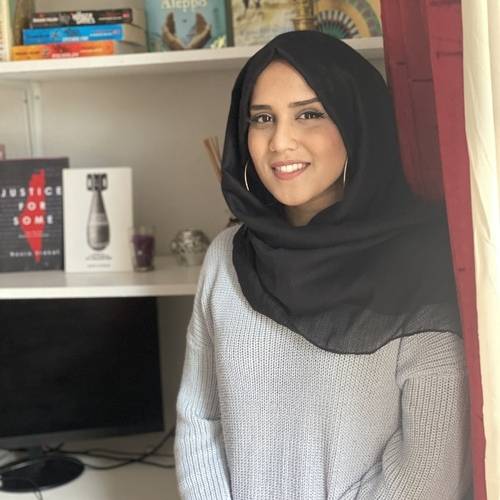Using one of the world’s most abundant and renewable elements, Palestinian sand artist Rana Al-Ramlawi highlights the Palestinian cause and Israel’s siege of the Gaza Strip in her work. Based in Tel Al-Hawa, an area of Gaza devastated by Israel’s bombardment in May, the 26 year old creates ephemeral sculptures out of sand and water at the beach near her home.
“I started sculpting with sand just over six years ago,” she told me. “It started as small, basic projects at first with no fine details, until my brother was shot in the foot by Israeli soldiers. That prompted my first large artwork.”
Ramlawi’s brother was severely injured by Israeli soldiers during the Great March of Return in 2018. The protest along the Gaza-Israel nominal border called for the implementation of the Palestinians’ legitimate right to return to their homes inside what is now Israel, as well as an end to Israel’s siege of the territory.
“After that incident, which affected me really badly, I decided to resist the occupation through my art,” she explained.
Over the years, she has crafted elaborate sandcastles, life-size images of Palestinian activists and victims of war, and even a giant sculpture of the Noble Sanctuary of Al-Aqsa. Most have some unique political significance. Each piece takes about five hours to make; sometimes even days.
READ: One former Palestinian prisoner escaped from an Israeli jail three times
Her latest artwork depicts the six Palestinian prisoners who escaped from Israel’s high-security Gilboa Prison on 6 September.
“Most of my messages concern the current human rights issues in our society and so, of course, my latest sculpture was of the Gilboa Prison escapees. The success of their escape meant a lot to us Palestinians and our fight for freedom so it was an automatic reaction to create something special at that moment.”
She described the news of the escape as “exhilarating” and something different in the news to what the Palestinians usually experience daily from the Israeli occupation.
The escape was a humiliating security breach for Israel. It sparked off a huge manhunt in northern Israel and the occupied West Bank.
“Even though they’ve been recaptured, the prisoners’ victorious escape through a tunnel dug with their own hands is still worth celebrating. I wanted to embody their victory and hope in my art; a universal message carved into the sand of Palestine.”
![Israel's inevitable failure: how a old rusty spoon defeated it - Cartoon [Sabaaneh/Middle East Monitor]](https://i0.wp.com/www.middleeastmonitor.com/wp-content/uploads/2021/09/IMG_3554-scaled.jpg?resize=920%2C571&ssl=1)
Israel’s inevitable failure: how a old rusty spoon defeated it – Cartoon [Sabaaneh/Middle East Monitor]
“Having first-hand experience of so many atrocities caused by Israeli bombs in our neighbourhoods has countless negative effects. It’s a relief to pour that heavy anguish into a sand sculpture, even though the artwork won’t last. It makes my pain feel temporary; that it too won’t last.”
The beach, she told me, is visited by people in their spare time and holidays, so it is a “perfect” place for her work and to raise awareness about the Palestinian cause. Art, she believes, also helps young people in the Gaza Strip to escape the difficult reality of their lives.
READ: Israel: police work in league with crime lords, say victims of gun violence
Mastering many styles and skills for sand sculpting, such as shaping, painting and brushing, takes time. While teaching basic education at refugee schools in Gaza, she also finds time to enhance her creative potential in sculpture and drawings with the children.
Al-Ramlawi’s first attempt at a sand sculpture came about by chance six years ago, while doodling in the sand. “Without a specific shape in my mind, I was playing with the wet sand after a rainy day and just sculpting curves that turned into circles, then those circles turned into simple body parts until without really noticing, it developed into a full statue.”
She uses a number of simple tools, including a thin wooden stick, to carve the wet sand, as well as a shovel, a trowel and some water. In order to document her work, she photographs and posts each work of art on social media before the inevitable disintegration happens.
“These sand works have so much of my emotion in them because they are about an important cause for me and my people,” concluded Rana Al-Ramlawi. “They allow us to communicate the Palestinian cause far and wide.”

![Palestinian sand artist, Rana Al-Ramlawi 29 September 2021 [rana_alramlawi/Instagram]](https://i0.wp.com/www.middleeastmonitor.com/wp-content/uploads/2021/09/New-Project-2.jpg?fit=920%2C613&ssl=1)







